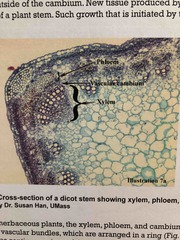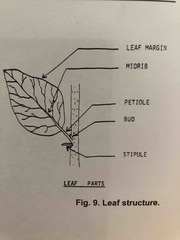![]()
![]()
![]()
Use LEFT and RIGHT arrow keys to navigate between flashcards;
Use UP and DOWN arrow keys to flip the card;
H to show hint;
A reads text to speech;
62 Cards in this Set
- Front
- Back
- 3rd side (hint)
|
What are the two life cycle phases of a seed-bearing plant? |
Vegetative and Reproductive |
|
|
|
How long does the vegetative phase last for annuals, biennials, and perennials, shrubs, and trees, respectively. |
Annuals- a few weeks Biennials- two growing seasons Perennials, shrubs, and trees- years |
|
|
|
When does the reproductive phase begin? |
Flower bud formation, flowering, and production of fruit and seed |
|
|
|
What are the three main functions of roots? |
-Anchor the plant -Absorb water and dissolved minerals from the soil -In some plants, store food |
|
|
|
What are the two major kinds of root systems? |
Fibrous and tap roots |
|
|
|
Bud |
A small protuberance on the stem of a plant that may develop into a flower, leaf, or shoot. |
|
|
|
Chlorophyll |
The green photosynthetic coloring matter found in plants, particularly in the leaves, where it is continually being manufactured. Known to have a vital role in converting carbon dioxide and water into simple sugars by the process of photosynthesis. |
|
|
|
Cross pollination |
Accomplished by either insects or wind, the transfer of pollen from the anthers of one flower to the stigma of another in order to effect fertilization of an ovary; fertilization must take place before seed can be produced. |
|
|
|
Crown |
The part of the plant where the stem and root join. |
|
|
|
Cutting (or slip) |
A way to propagate plants by breaking or cutting off a portion of a branch or root and planting it in soil or water so that it can grow roots and in time become a plant exactly like the parent one. |
|
|
|
Dividing |
A method for increasing plants such as bulbs, perennials, and other plants that spread by developing roots and tips in clumps (e.g., hosts, iris, daylilies). Accomplished by digging up all or a portion of a plant, breaking apart the rooted sections, and replanting. |
|
|
|
Fibrous root system |
Made up of many branched roots and rootlets (sometimes with no taproot development as distinguished from bulbous or tuberous roots). |
|
|
|
Flower |
Usually a symmetrical form of colorful growth with the primary purpose being to produce seed for seed subsequent reproduction. The seed bearing plant’s reproductive organ. |
|
|
|
Germination |
The sprouting of a seed and the commencement of growth. (Also used to mean the starting of plants from seeds.) |
|
|
|
Husk |
The dry outer covering of certain seeds, of which the most commonly known is the corn husk. |
|
|
|
Layering |
A propagating technique in which the stem of a woody plant is bent down and buried in a rooting medium in order to force the development of roots along the buried portion of stem. Commonly seen with Forsythia. |
|
|
|
Node |
A joint or point where a branch, bud, or leaf meets the stem from which it develops. |
|
|
|
Petiole |
The stalk of the leaf that attaches the leaf blade to the stem of the plant. |
|
|
|
Pollen |
Microscopic dust-like grains, produced on the anthers of flowers, which contain male sex cells. Dry pollen is transported by the wind, sticky pollen by birds and insects. Each pollen grain, after coming to rest on the stigma of a pistol, will produce sperm cells to fertilize an ovule. |
|
|
|
Pollination |
This term is used to mean the transfer of pollen from the stamens (staminate flower) to the pistils (pistillate flower). Plants are either cross-pollinated or self-pollinated. Cross-pollinating means the transfer of pollen from flowers of one plant to the flowers of another (either of the same species or a different species). Self-pollinating takes place when pollen is transferred between the reproductive organs of an individual flower or between flowers on the same plant (e.g., sweet peas). |
|
|
|
Stolon |
A horizontal branch from the base of a plant that produces new plants from buds at its tip. It creeps along the surface of the ground rooting now and then and forming new plants. |
Bermuda grass |
|
|
Tap root |
A main root descending downward in the soil and giving off small lateral root. |
Carrots, dandelions |
|
|
Rhizome |
An underground stem that spreads by creeping; produces shoots above and roots below. |
Iris and Jerusalem Artichoke |
|
|
Root cutting |
A portion of a root or a root used for propagation. |
|
|
|
Runner |
A long, thin, trailing stem that develops new plants when the nodes contact the soil. |
Strawberry |
|
|
Seed |
The small grains produced by flowering plants containing embryos which germinate to produce new plants. |
|
|
|
Seed germination |
The beginning of growth of the young plant in a seed when heat, moisture, and air are provided. |
|
|
|
Seedling |
The young plant emerging from a germinating seed. If seeds are sown thickly in a seed bed, for example, they soon begin to fight for sufficient growing room. As their true leaves appear, they should be transplanted to bed or box until they are ready for transplant to the garden. |
|
|
|
Softwood cutting |
A cutting of a young shoot taken from a woody or herbaceous plant before it has hardened. These cuttings are then planted into a rooting medium for propagation. |
|
|
|
Sprig |
A small twig or shoot. |
|
|
|
Sprout |
The term used to denote the development of new growth from seed. Also the development of new shoots. |
|
|
|
What are buds located at the ends of stems called? |
Terminal or apical buds |
|
|
|
What happens in the apical meristem? |
Cells dividing |
|
|
|
What are the processes responsible for growth? |
Cell division and cell elongation |
|
|
|
Growth initiated in terminal buds is referred to as what and what happens? |
Primary growth and leads to an increase in length of stems. |
|
|
|
Buds occurring along the sides of stems are called what? |
Lateral buds |
|
|
|
Axillary bud |
A lateral bud which originated in the axis of a leaf. Give rise to branches, but sometimes they may also form flowers. |
|
|
|
What are the three main functions of stems? |
- Support and hold leaves up to the light so plant food can be manufactured. - Conduct or move water, nutrients, and plant food (carbohydrates). - Food storage. Tubers, rhizomes, and corms. |
|
|
|
What makes up the vascular system of plants and their specific functions? |
Xylem and phloem. Xylem moves water and dissolved nutrients. Phloem moves plant food (carbohydrates) manufactured in leaves and green stems. |
|
|
|
Dicotyledonous plants |
Plants whose seeds have two cotyledons or seed leaves |
|
|
|
Xylem and phloem are separated by what and what is its function? |
A layer of tissue called the vascular cambium or cambium layer. This layer continuously divides, producing xylem cells in the inner side and phloem cells on the outside of the cambium. New tissue produced by the cambium is responsible for increase in girth of a plant stem. |

|
|
|
Growth initiated by the cambium layer is called what? |
Secondary growth |
|
|
|
Vascular bundles contain what? |
Xylem, phloem, and cambium |
|
|
|
Monocotyledonous plants |
Single seed leaf |
|
|
|
What is the food-making process in plants called and how does it occur? |
Photosynthesis. It occurs when carbon dioxide (CO2) and water (H2O) are transformed into sugars (glucose) from visible light that is absorbed by chlorophyll (green pigment) found in leaves and green stems. |
|
|
|
What is transpiration? |
Water lost into the atmosphere by leaves and stems of plants |
|
|
|
What causes a water deficit? |
When loss of water is greater or more rapid than absorption; a considerable deficit will cause wilting. |
|
|
|
Leaf structure |

Back (Definition) |
|
|
|
What is the typical structure of dicots? Monocots? |
Dicots have a netted venation, with one or more important veins forming a conspicuous midrib. Monocots, such as corn and many grass species, have parallel-veined leaves with inconspicuous branching between the veins. |

|
|

Front (Term) |
Diagram of flower parts |
|
|
|
Sepals |
An outer set of floral leaves which enclose the other parts of the flower until these are nearly mature. Most often, sepals are green in color, but on some flowers such as lilies, they will be the same color as the petals. |
|
|
|
Calyx |
The sepals of a flower, collectively. |
|
|
|
Petals |
An inner set of colored or white floral leaves make up the corolla. In many flowers, the petals are showy and may help in attracting the attention of insects which assist in pollination. |
|
|
|
Stamens |
Within the petals are one or more sets of stamens (male reproductive organs). Stamens are composed of pollen-bearing anthers supported by a filament. When pollen is mature, it is discharged through a rupture or a pore in the anther wall. |
|
|
|
Pistils |
At the center of the flower are one or more pistils (female reproductive organs). Pistils consist of an ovule-bearing (or ovary) supporting an elongated region (or style) whose expanded tip or surface is called the stigma. The ovule becomes the seed. The mature ovary becomes the fruit. |
|
|
|
Receptacle |
An enlarged part of the flower-supporting stem where the flower parts are borne |
|
|
|
Vegetative reproduction |
Means of reproducing other than by seed; cuttings, grafting, layering, division, and separation using stems, runners, tuberous roots, and underground stems |
|
|
|
Grafting |
The joining together of two different plant parts so they will fuse and continue to grow as one unit. The upper portion is the scion, while the under part is the stock (rootstock, understock). Special effects- “tree roses” Some grafting is necessary because certain soil pathogens make it impossible to grow some plants on their own roots (gardenias, roses). Dwarfing effect Certain citrus varieties are grafted on special rootstocks because the rootstock is more resistant to cold or wet soils. Success depends on how well the cambium layers of the scion and stock match up. |
|
|
|
What are considered the “optimum growing conditions”? (6) |
Sunlight, day-length (photo period), temperature (day, night, seasonal), air moisture (humidity), rainfall, and soils (texture and pH). |
|
|
|
The process by which carbon dioxide and water are combined in the presence of light to form sugar is called: a) Respiration b) Photosynthesis c) Transpiration |
b) Photosynthesis |
|
|
|
Monocotyledonous plants and dicotyledonous plants differ in which way? a) Monocots have no true stems b) The arrangement of xylem, phloem and cambium c) Dicots always grow larger than monocots d) None of the above |
b) The arrangement of xylem, phloem, and cambium |
|
|
|
The part of the flower where pollen lands and sprouts to fertilize the ovary is called the receptacle. a) True b) False |
b) False (stigma) |
|

